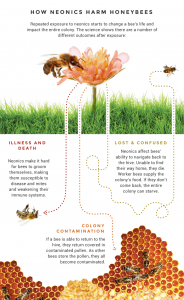Honeybees are flying insects and they pollinate one third of the world’s flowering plants and food crops. With enormous amounts of food being cultivated all around the globe, copious amounts of pesticides and insecticides are regularly applied to these flowers and crops everyday. The use of these weed and insect killers directly and indirectly affects honey bees ability to do their job. Pesticides can have many negative side effects that can affect honeybees behavioural patterns, mating rituals, foraging rates and can cause decreased brain and motor function which potentially leads to paralysis, convulsions, and forgetfulness of floral scents.
According to Alex J. Guseman (2016) “pesticide exposure” to honey bees is one of the main reasons for their high mortality rate. Research conducted by his team showed that compounds like fumagillin and quercetin interfere with the transportation system within the honeybees, thereby ultimately leading to the death of honey bees (Guseman et al. 2016). They used ivermectin as a model substrate for their research which is an “anthelmintic and acaricidal medication”. Ivermectin interacts with multi-drug resistance transporters which target the chloride channels of the nervous system of honeybees (Guseman et al. 2016).The reason why honeybees are drastically affected is because their genetic system is unable to produce the detoxifying enzymes. (Anderson and Atkins 1958).
The types of pesticides and herbicides that negatively impact not only the honey bees, but queen bees as well are caused in two ways. This happens when bees are on the flower at the point when farmers are applying those insecticide, and the bees dies directly from the immediate ingestion. Thus these materials are safe to use when the bees are not present in the field. The second and more deadly way is when the bee comes in contact with a pesticide and transports it back to the hive, either as contaminated pollen, nectar or simply on its body. Bringing the contamination to the hive promotes the spread of poisonous elements and endangers every bee in the hive.(Anderson et al. 1958)
Existence of honeybee queens relies generally on best improvement to sexual maturity suitable behavioural, anatomical development and physiological progressions that leads to fruitful mating.Therefore, ill impacts on the queen’s reproductive system may bring about unfavorable conditions in anatomy and physiology, which can cause expensive “queen replacement” to the colony.Moreover, they observed “ovariole hyperplasia in neonicotinoid-exposed queens” compared to controls (Williams et al.2015). Furthermore, they observed that a large decrease in the number and quality of “spermatozoa inside queen spermathecae”(Williams et al. 2015). It can be concluded that “neonicotinoids, because of neuronal hyper-excitation” result in brokenness of queen physiology and anatomy responsible for transporting and storing newly-received “drone spermatozoa during mating”(Williams et al. 2015). Proper storage of adequate quantities of spermatozoa is need for the existence of queen otherwise it will be replaced by a colony after the depletion of healthy spermatozoa (Williams et al. 2015).However,there has been growing concern over the use of neonicotinoid pesticides in the agriculture and the sub-lethal effects they can have on pollination. Sub-lethal effects do not bring about direct mortality but impact on an organism’s ability to function in some other way, for example: by impacting on the activities, fecundity, neurophysiology learning performance or other aspect of behavior. There is mounting evidence that neonicotinoid pesticides,formulated to target neurotransmitter receptors in insects,are negatively impacting the foraging bees by inducing memory and learning dysfunctional , and impairing navigational skills.Moreover, the recent study found that bees colonies exposed to field produced 85% fewer queens than control colonies.There is an evidence that there is reduction in the number of queens and foraging working bees[whitehorn et al.2012]
In conclusion, the use of pesticides on crops and flowering plants have many hazardous impacts that directly and indirectly affect these vital insect pollinators. Scientists believe that the bee crisis can entirely shatter the world food security that is already affected by the economic crisis (Riscu and Bura 2013). The continued misuse of pesticides will give rise to an accelerated decline of honey bees. Not only will we see a disappearance of honey bees but also other various important insects that all play vital roles in balancing and maintaining healthy ecosystems.
Figure 1. Represents effects of pesticides on honeybees.
Picture credits: http://earthjustice.org/features/infographic-bees-toxic-problem
References:
Anderson L.D and Atkins E.L .1958. Effects of pesticides on bees. California Agriculture. [Internet] [cited 2016 March 27] Available from: https://ucanr.edu/repositoryfiles/ca1212p3-64697.pdf
Guseman AJ., Miller K, Kunkle G, Dively GP, Pettis, J.S, Evans JD, Hawthorne DJ. 2016. Multi-drug resistance transporters and a mechanism-based strategy for assessing risks of pesticide combinations to honey bees. PLOS ONE, 11(2), 1-15. [Internet] [cited 2016 March 28] doi:10.1371/journal.pone.0148242
Hannah F, Kirsty P, Dave G. 2014.Field realistic of pesticide imidacloprid reduce bumblebee pollen foraging efficiency.Springer science 22 [1]:317-318.
Riscu A, Bura M. 2013. The impact of pesticides on honey bees and hence on humans’. Scientific Papers: Animal Science and Biotechnologies. Vol. 46 no. 2, pages 272-277. [Internet] [cited 2016 April 03] Available from: http://spasb.ro/index.php/spasb/article/view/129/332
Williams R.G, Troxler.A, Retschnig .G, Roth .K, Yanez.O , Shutler .D, Neumann .P, Gauthier .L 2015. Neonicotinoid pesticides severely affect honey bee queens.[Internet] [cited 2016 April 02] Available from: http://www.nature.com/articles/srep14621 doi; 10.1038/srep14621

